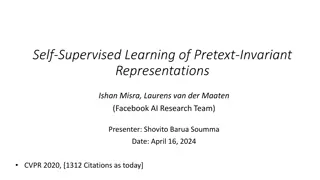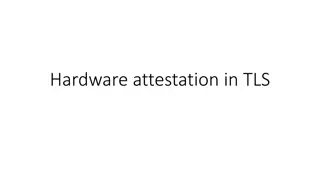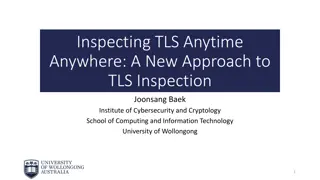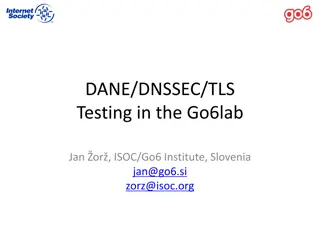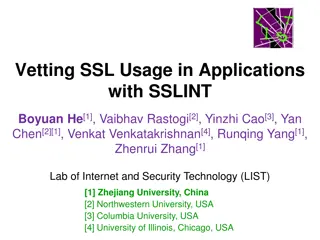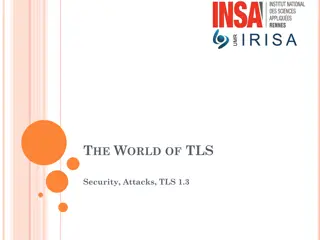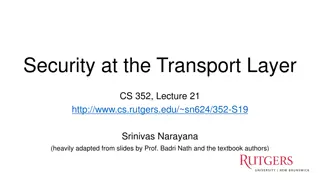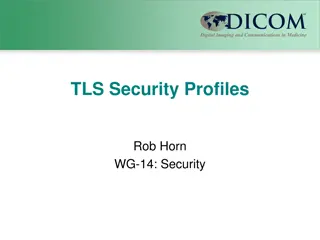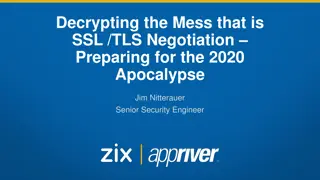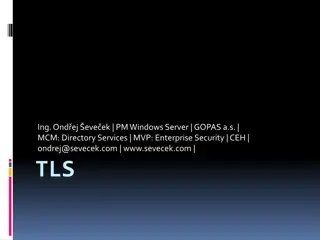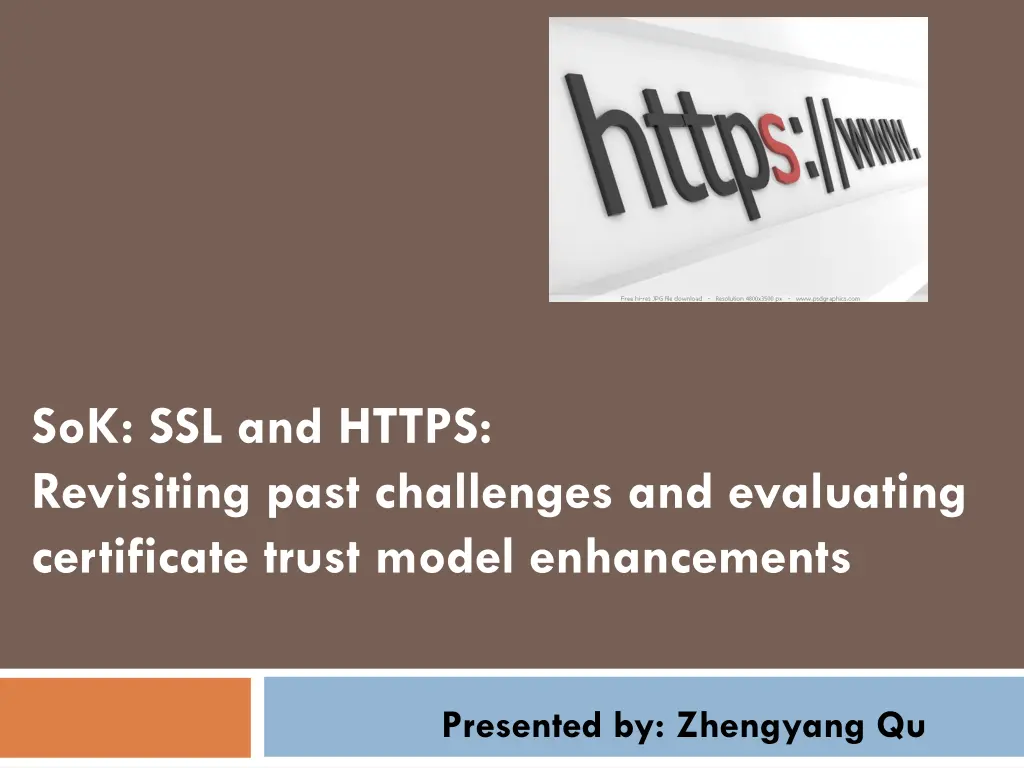
Revisiting Challenges in HTTPS and SSL
Explore the challenges and advancements in the SSL and HTTPS protocols, focusing on issues in cryptographic protocols, trust models, and security enhancements. Delve into weaknesses in encryption, signature key lengths, protocol implementation flaws, and protocol-level attacks, offering insights into ongoing research and discussions in the field.
Download Presentation

Please find below an Image/Link to download the presentation.
The content on the website is provided AS IS for your information and personal use only. It may not be sold, licensed, or shared on other websites without obtaining consent from the author. If you encounter any issues during the download, it is possible that the publisher has removed the file from their server.
You are allowed to download the files provided on this website for personal or commercial use, subject to the condition that they are used lawfully. All files are the property of their respective owners.
The content on the website is provided AS IS for your information and personal use only. It may not be sold, licensed, or shared on other websites without obtaining consent from the author.
E N D
Presentation Transcript
SoK: SSL and HTTPS: Revisiting past challenges and evaluating certificate trust model enhancements Presented by: Zhengyang Qu
Roadmap Background Crypto Protocol Issues in HTTPS Trust Model Issues in HTTPS Security Enhancements to CA/B Model Discussion & On-going Research
Background Objectives Confidentiality Server Authentication, Client Authentication (Optional) Protocol Specification and Implementation HTTPS: combination of HTTP with SSL/TLS Client-side (by OS or browser) Firefox: Mozilla s NSS, Chrome: underlying OS Windows, OS X, or NSS on Linux Server-side Apache (OpenSSL), Windows Server (ISS), Solaris (NSS)
Roadmap Background Crypto Protocol Issues in HTTPS Trust Model Issues in HTTPS Security Enhancements to CA/B Model Discussion & On-going Research
Crypto Protocol Issues in HTTPS Weakness in Cryptographic Primitives Weak Encryption & Signature Key Lengths Symmetric key encryption scheme with 40, 56, or 64 bit keys is subject to a brute-force attack. Asymmetric encryption schemes like RSA are subject to factoring attacks when used with a 512 bit modulus. ax=b (mod n) Weak Hash Functions Collision-resistance & Second Preimage Resistance MD5, MD2
Crypto Protocol Issues in HTTPS Implementation Flaws & Related Attacks Pseudorandom Generator (PRG) Seeding Remote Timing Attack Oracle Attacks RSA Encoding Cipher Block Chaining (CBC) Initialization Chosen Plaintext Attacks Compression CBC Padding
Crypto Protocol Issues in HTTPS Protocol-level Attacks Ciphersuite Downgrade Attack Version Downgrade Attack Renegotiation Attack Cross-protocol Attack Diffie-Hellmen or RSA Not state which key agreement algorithm is used Client Traffic Server Client Attacker Handshake Initial Traffic Handshake
Roadmap Background Crypto Protocol Issues in HTTPS Trust Model Issues in HTTPS Security Enhancements to CA/B Model Discussion & On-going Research
Trust Model Issues in HTTPs Certification Domain Validated (DV) & Extended Validated (EV) Security Issues Hostname Validation (CAs) E-mail validations: top-level domain (admin@domain) WhoIS record Hostname Validation (Clients) Parsing Attack (e.g. bank.com evil.com) Mismatch between CA parsing and browser parsing EV Downgrading
Trust Model Issues in HTTPs Anchoring Trust Software Vendors Private Networks (e.g. corporate environment) Security Issues CA Compromise MITM attack (e.g. two compromised CAs Comodo & DigiNotar) Compelled Certificates Nation-states, government (e.g. connection to Facebook via ISPs in Syria)
Trust Model Issues in HTTPs Transitivity of Trust Intermediate CA certificates Path Validation Algorithm Constraints: (1) CA: TRUE (2) pathlen: n Lack of further chain discovery mechanism Intermediate CAs are invisible to client before being encountered
Trust Model Issues in HTTPs Maintenance of Trust Terminate the Validity of a certificate before expiration Get Revocation Status: CRLs & OCSP (updated on- demand) Responsive Revocation Security Issues Blocking Revocation Ownership Transfer Domain: fb.com
Trust Model Issues in HTTPs Indication and Interpretation of Trust Browser Security Cues, Browser Security Warnings, Mixed Content, Mobile Browsers, HTTP Form Submit Security Issues Stripping SSL/TLS Spoofing Browser Chrome Conceding a Warning
Roadmap Background Crypto Protocol Issues in HTTPS Trust Model Issues in HTTPS Security Enhancements to CA/B Model Discussion & On-going Research
Security Enhancements to CA/B Model Security Properties Offered by Primitives Detecting Certificate Substitution Detecting SSL/TLS Stripping PKI Improvements Evaluation Criteria for Impact on HTTPS Security & Privacy Deployability Usability
Security Enhancements to CA/B Model Evaluation of Proposed Primitives Certificate Pinning (Client History) Detection of certificate substitution attacks Certificate Pinning (Server) Better level of granularity Certificate Pinning (Browser Platform) Avoid blind TOFU approach Certificate Pinning (DNS) Who conduct the validation? DNSSEC, DANE
Security Enhancements to CA/B Model Multipath Probing Crowdsourcing Objective information (time-based and space-based) Subjective information (Omnibroker, Monkeysphere) Convergence (Firefox), DoubleCheck, Certificate catalogue (Google)
Security Enhancements to CA/B Model Channel-bound Credentials Modify the authentication value in cookies Credential-bound Channels Key Continuity/Manifest Server-side changes TACK, DANE, DVCert
Security Enhancements to CA/B Model HTTPS-only Pinning Many primitives are never invoked unless an HTTPS connection is requested Domain only supports HTTPS and communicates that with client via a pin Request headers or TLS extensions Pre-established in browser DNS record of the site
Security Enhancements to CA/B Model Visual Cues for Secure POST (e.g. SSLight) Browser-stored CRL Certificate Status Stapling Short-lived Certificates List of Active Certificates, Whitelist
Roadmap Background Crypto Protocol Issues in HTTPS Trust Model Issues in HTTPS Security Enhancements to CA/B Model Discussion & On-going Research
Discussion & On-going Research Protocol-level TLS-Analysis & Modification Trust Model Infrastructure Realistic reflection of trust in the digital world? Human Element & the Security User Interface Raising the Bar Combine the primitives into the infrastructure Replace the functionality of CAs (e.g. DANE) Provide recognizable assurance to users
Thank you! Thank you!
Discussion & On-going Research Important Orthogonal Problems Gap between the user s cognitive notion of what organization connected and the domain name in certificate Condition for read/write access to cookies Compromised client-platform

